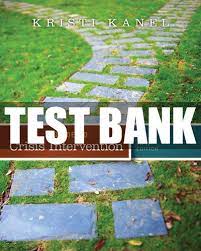Test Bank For A Guide to Crisis Intervention 5th Edition
Digital item No Waiting Time Instant DownloadISBN-13: 978-1285739908 ISBN-10: 1285739906
In Stock
Original price was: $65.00.$22.00Current price is: $22.00.
Test Bank For A Guide to Crisis Intervention 5th Edition
CHAPTER 1: WHAT IS A CRISIS AND CRISIS INTERVENTION?
Multiple Choice
1. Ego strength refers to:
A. how proud and self-centered the person is.
B. the amount of energy available to overcome post-traumatic stress disorder.
C. the ability to understand the world realistically and act upon it to get one’s needs met.
D. all of the above.
E. none of the above.
ANS:C
2. The outcome of a person’s crisis is determined by his or her:
A. material resources.
B. personal resources.
C. social resources.
D. all of the above.
E. none of the above.
ANS:D
3. The cognitive key refers to:
A. the precipitating event.
B. the coping strategies.
C. the meaning given to the precipitating event.
D. both A and B.
E. none of the above.
ANS:C
4. Which of the following is NOT an example of effective coping behavior according to Caplan?
A. Actively exploring reality issues
B. Learning to stifle emotions and contain them
C. Actively invoking help from others
D. All of the above
E. None of the above
ANS: B
5. An example of effective coping behavior is:
A. learning to accept that oneself cannot be trusted in crisis situations.
B. learning to master the problem as it comes to you as a whole.
C. mastering feelings where possible.
D. none of the above.
ANS:C
6. The curvilinear model of anxiety proposes:
A. anxiety is always negative and serves no purpose.
B. anxiety may be used to increase motivation.
C. anxiety should be avoided at all costs.
D. none of the above.
ANS:B
7. Which best describes the trilogy definition of a crisis?
A. A person experiences stress, suffers a nervous breakdown, and requires hospitalization
B. A precipitating even occurs, subjective distress is experienced, coping fails
C. An abnormal state which is caused by personality disorders, psychosis or organicity
D. Both A and B
E. None of the above
ANS:B
8. A crisis can be an opportunity because:
A. the person can grow from the challenge of dealing with the precipitating event.
B. the person can seek financial opportunity by winning malpractice lawsuits or workman’s compensation.
C. the person may learn to use ego defense mechanism.
D. all of the above.
E. none of the above.
ANS:A
9. A person in crisis may be in danger of:
A. becoming psychotic.
B. committing suicide.
C. coming through the crisis at a lower level of functioning.
D. all of the above.
E. none of the above.
ANS:D
10. Which of the following might determine how well someone manages a crisis?
A. Material resources
B. Personal resources
C. Social resources
D. All of the above
ANS: D
11. Caplan believed that all of the following are characteristics of effective coping behavior EXCEPT:
A. actively exploring reality issues.
B. trusting in oneself.
C. freely expressing feelings.
D. none of the above.
ANS: D
12. The crisis-prone person usually:
A. has access to their ego to deal with stress.
B. has depleted their ego strength and operates defensively.
C. engages in problem solving behaviors under stress.
D. all of the above.
ANS: B
13. Eric Lindemann studied:
A. the reactions of Vietnam veterans.
B. the reactions of the relatives of victims in the Coconut Grove fire.
C. the reactions of the Iraqi Veterans of 2003.
D. the reactions of sexually-abused children.
ANS:B
14. The concept of finite psychic energy comes from which theory?
A. Darwin’s
B. Psychoanalytic
C. Existential
D. Humanistic
E. None of the above
ANS: B
15. The empowerment model of crisis intervention where responsibility and choice are emphasized probably best represents which approach?
A. Existential
B. Humanistic
C. Behavioral
D. None of the above
ANS: A


Reviews
There are no reviews yet.